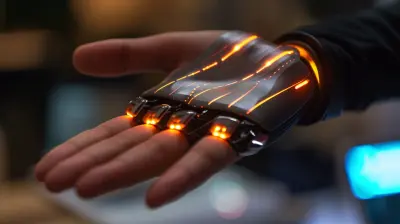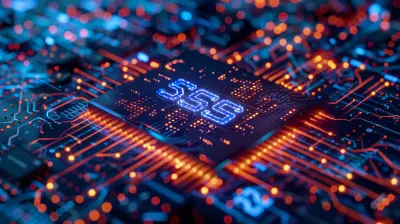The Role of Blockchain in Securing IoT Networks
2 May 2025
Imagine a world where billions of smart devices—everything from your smartwatch to your fridge—communicate seamlessly. Sounds exciting, right? But here’s the catch: with such widespread connectivity comes an ever-growing risk of cyber threats. Hackers, data breaches, and unauthorized access are just a few nightmares lurking in the shadows of IoT (Internet of Things) networks.
So, how do we ensure security in this ever-connected digital landscape? Enter blockchain, the decentralized, tamper-proof technology originally designed for cryptocurrencies, now stepping into the IoT scene like a guardian angel. But how exactly does blockchain secure IoT networks? Stick around as we unravel this intriguing blend of technology. 
The Growing Security Nightmare in IoT
IoT devices are everywhere. Smart homes, autonomous cars, industrial sensors, and even medical devices all rely on constant data flow. While this interconnected ecosystem is incredibly convenient, it also creates a massive security loophole. Let’s break it down:Vulnerabilities of IoT Networks
1. Weak Authentication – Ever used "123456" or "password" for your Wi-Fi? Many IoT devices still operate on default or weak passwords, making them an easy target.2. Centralized Infrastructure – Most IoT networks rely on centralized cloud servers, creating a single point of failure. Once breached, everything is compromised.
3. Data Integrity Risks – Hackers can manipulate real-time IoT data, leading to disastrous consequences, especially in sectors like healthcare or autonomous transport.
4. DDoS Attacks – Cybercriminals often hijack thousands of IoT devices to launch Distributed Denial-of-Service attacks, overwhelming servers and causing disruptions.
Clearly, IoT security isn’t something we can afford to ignore. But fear not, because blockchain might be the ultimate solution. 
How Blockchain Secures IoT Networks
Picture blockchain as a vault with an unbreakable combination lock. Each piece of IoT data is stored in a tamper-proof, decentralized ledger, making unauthorized modifications nearly impossible. Here’s how blockchain transforms IoT security:1. Decentralization Eliminates Single Points of Failure
Traditional IoT systems rely on centralized cloud storage. But if that system is hacked, everything collapses. Blockchain, on the other hand, eliminates central authority by distributing control across multiple nodes. This means no single entity holds absolute power, making it incredibly hard for attackers to compromise the entire network.2. Immutable Data Records Prevent Tampering
Blockchain creates an immutable ledger, meaning once data is recorded, it cannot be altered or deleted. This ensures that IoT records, like healthcare reports or smart contract operations, remain untouched and authentic. For cybercriminals, trying to manipulate data on a blockchain is like trying to erase ink from a stone tablet—virtually impossible.3. End-to-End Encryption Enhances Privacy
Unlike traditional systems that store plaintext data, blockchain encrypts IoT transactions, ensuring end-to-end security. This means that even if hackers intercept data, all they see is meaningless gibberish without the decryption key.4. Smart Contracts Automate Secure Transactions
Smart contracts are self-executing programs embedded with predefined conditions. In IoT, they can automate actions without human intervention, reducing the risk of tampering. For example, in a smart supply chain, an IoT sensor can detect malfunctioning goods and trigger a blockchain-backed smart contract to initiate an automatic replacement order—no middlemen, no foul play.5. Secure Identity Management for IoT Devices
Ever heard of spoofing attacks? Hackers can masquerade as legitimate IoT devices to gain access to critical systems. Blockchain solves this with decentralized identity (DID) solutions, where each IoT device has a unique cryptographic identity, making it harder to impersonate.
Real-World Applications of Blockchain in IoT
Now that we’ve covered the theory, let’s dive into some real-life use cases where blockchain is revolutionizing IoT security.1. Smart Homes and IoT Security
Imagine living in a fully automated smart home where everything, from your coffee maker to your security cameras, runs on IoT. Sounds futuristic, right? The problem? Hackers can control your home remotely if security is weak. Blockchain ensures that IoT devices in smart homes communicate securely and only with verified identities, preventing unauthorized access.2. Blockchain in Healthcare IoT
With connected medical devices monitoring patients 24/7, healthcare is more advanced than ever. But a data breach could mean leaked patient information or, worse, tampered medical records. With blockchain, patient data is encrypted and stored securely, preventing unauthorized modifications or leaks.3. Supply Chain and Logistics
Ever wondered how blockchain keeps your Amazon package secure? IoT sensors track shipments in real time, while blockchain logs every transaction—ensuring zero fraud, zero manipulation. If there’s a discrepancy, everyone on the network can verify whether the data has been altered or not.4. Automotive and Autonomous Vehicles
Imagine a hacker taking control of a self-driving car—terrifying, right? Blockchain secures vehicle-to-vehicle (V2V) communication by ensuring that data exchanged between autonomous vehicles is authentic, tamper-proof, and encrypted.5. Industrial IoT (IIoT) and Smart Factories
Large industries use IoT sensors to monitor machinery, detect failures, and automate repairs. Blockchain ensures that data coming from these sensors is accurate, secure, and immutable—preventing malicious actors from manipulating it.
Challenges of Implementing Blockchain in IoT
While blockchain offers promising solutions, it’s not a magic bullet. There are challenges that need addressing:1. Scalability Issues
IoT networks generate an overwhelming amount of data every second. Blockchain’s decentralized nature can sometimes struggle to handle this massive load. Solutions like sharding and off-chain transactions are being explored to overcome this.2. Energy Consumption
Blockchain, especially proof-of-work (PoW) models, consumes a significant amount of energy. This isn’t ideal for IoT devices with limited battery life. However, newer consensus mechanisms like proof-of-stake (PoS) and DAG (Directed Acyclic Graphs) offer promising alternatives.3. Initial Costs and Integration
Transitioning from traditional cloud-based IoT systems to blockchain-powered security models requires a significant investment. Businesses have to weigh the costs against the long-term security benefits.The Future of Blockchain-Powered IoT Security
The fusion of blockchain and IoT is still in its early days, but the potential is limitless. As technology advances, we’ll likely see:- More energy-efficient blockchain models tailored for IoT applications.
- AI and blockchain-powered cybersecurity solutions embedding real-time threat monitoring.
- Increased adoption of decentralized identity (DID) frameworks to secure IoT devices.
In the coming years, blockchain could very well become the bedrock of IoT security, safeguarding everything from smart homes to critical infrastructures. The question isn’t whether blockchain will secure IoT—it’s how soon we’ll embrace it at scale.
Final Thoughts
IoT is reshaping the world, making our lives more connected and convenient. But with great connectivity comes great vulnerability. Traditional security measures just aren’t cutting it anymore—hence, the blockchain revolution.From decentralized security to tamper-proof data, blockchain is emerging as the ultimate shield against cyber threats. While challenges exist, the benefits clearly outweigh the risks. One thing’s for sure: the future of IoT security is decentralized, transparent, and blockchain-powered.
So, next time you unlock your smart door with a tap on your phone, think about what’s securing it. If it’s blockchain, you’re in safe hands.
all images in this post were generated using AI tools
Category:
Iot DevicesAuthor:

Gabriel Sullivan
Discussion
rate this article
8 comments
Soren Ross
While blockchain shows promise in securing IoT networks, its scalability and energy consumption challenges must be addressed to realize its full potential in practical applications.
May 11, 2025 at 4:16 AM

Gabriel Sullivan
Thank you for your comment! You’re absolutely right—scalability and energy efficiency are crucial for blockchain’s integration into IoT. Addressing these challenges will be key to unlocking its full potential in securing networks.
Adam Whitley
This article effectively highlights the potential of blockchain technology in enhancing IoT network security. While promising, it’s essential to also consider challenges such as scalability and integration with existing systems for a comprehensive understanding.
May 10, 2025 at 12:09 PM

Gabriel Sullivan
Thank you for your insights! You’re absolutely right—addressing scalability and integration challenges is crucial for fully realizing blockchain's potential in IoT security.
Ace Rocha
In realms where data dances free, Blockchain weaves a tapestry, Guarding whispers of the IoT, With chains of trust, where all can see. Immutable, it stands so bold, An iron shield ‘gainst tales untold. In digital skies, our dreams ignite, Secure the future, tethered tight.
May 8, 2025 at 12:37 PM

Gabriel Sullivan
Thank you for your poetic reflection! You've beautifully captured the essence of blockchain's role in enhancing IoT security through transparency and trust.
Eloise Cain
This article highlights the transformative potential of blockchain in enhancing IoT security. By decentralizing control and ensuring data integrity, blockchain can effectively mitigate vulnerabilities, paving the way for safer and more reliable IoT ecosystems. Great insights!
May 7, 2025 at 12:42 PM

Gabriel Sullivan
Thank you for your positive feedback! I'm glad you found the insights on blockchain's potential in enhancing IoT security valuable.
Verity Cummings
Blockchain isn't just a buzzword; it’s the fortress IoT networks desperately need. Embrace its power to eliminate vulnerabilities and revolutionize security in our connected world.
May 6, 2025 at 7:40 PM

Gabriel Sullivan
Thank you for your insightful comment! Indeed, blockchain holds great potential to enhance IoT security by providing a robust framework to mitigate vulnerabilities and ensure data integrity in our interconnected environment.
Beatrice Scott
This article effectively highlights blockchain's potential to enhance IoT security, but it could benefit from more real-world examples to illustrate its practical application.
May 6, 2025 at 10:48 AM

Gabriel Sullivan
Thank you for your feedback! I appreciate your suggestion for real-world examples and will consider incorporating them in future revisions.
Zyana McFee
Great insights on the intersection of blockchain and IoT! The potential for enhanced security and trust in connected devices is truly exciting. Looking forward to seeing these innovations unfold!
May 4, 2025 at 3:52 AM

Gabriel Sullivan
Thank you! I appreciate your enthusiasm for the topic. Exciting times ahead as we explore these innovations!
Zevon Daniels
Great insights! Excited to see how blockchain enhances IoT security. Well done!
May 3, 2025 at 6:25 PM

Gabriel Sullivan
Thank you! I'm glad you found the insights valuable. Exciting times ahead for blockchain and IoT!
MORE POSTS

Biometric Tech: Unlocking the Next Generation of Security

How Advanced Haptics are Enhancing the Gadget Experience

The Role of AR Glasses in Enhancing Museum and Art Experiences

Bose SoundLink vs. JBL Flip: Best Portable Bluetooth Speaker

How Cybersecurity is Adapting to the Rise of 5G Technology

The Role of AR Glasses in Enhancing Military Operations